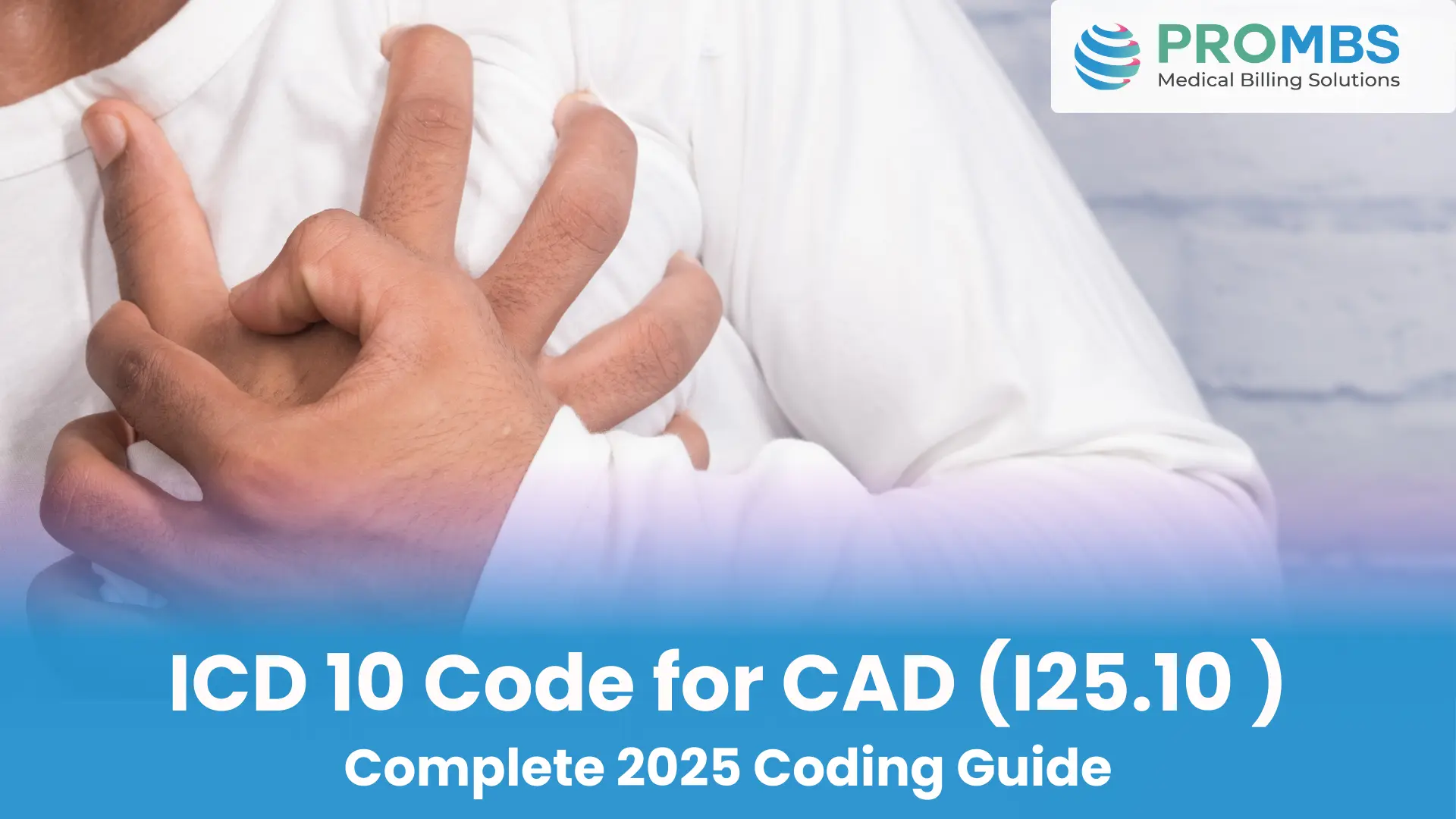375,000 deaths each year are attributed to coronary artery disease (CAD) in the United States, making it the nation’s leading cause of death according to the Centers for Disease Control and Prevention (CDC). Beyond this staggering mortality rate, CAD drives billions of dollars in healthcare spending annually, with hospitalizations, interventions, and follow-up care placing a heavy burden on both patients and providers. For healthcare organizations, accurate ICD-10 coding is not only critical for clinical reporting but also for compliance, risk adjustment, and financial sustainability.
Incorrect use of the ICD-10 code for CAD is a key factor behind denials in cardiology claims. Studies estimate that 15–20% of cardiology claims are rejected, most often due to incomplete documentation or ICD/CPT mismatches. Properly linking CAD diagnosis codes with the correct CPT procedures ensures payer compliance, reflects patient complexity, and secures maximum reimbursement.
From a compliance standpoint, CAD coding falls under Chapter IX of ICD-10-CM (Diseases of the Circulatory System). Coders must capture whether the disease involves native coronary arteries, bypass grafts, or stents, as well as the presence and type of angina. Documenting associated comorbidities like hypertension, diabetes, and hyperlipidemia further strengthens coding accuracy and supports HCC risk adjustment, which directly impacts provider revenue.
What is CAD (Coronary Artery Disease)?
Coronary artery disease (CAD) occurs when plaque builds up inside the coronary arteries, restricting blood flow to the heart muscle. Over time, this narrowing increases the risk of angina, myocardial infarction (MI), and other serious complications.
From a coding perspective, CAD is classified under Ischemic Heart Diseases in the ICD-10-CM coding manual. Proper use of the ICD 10 code for CAD ensures accurate clinical reporting, risk adjustment, and reimbursement.
Symptoms of CAD to Support ICD 10 Coding
Providers should document the presenting symptoms that support the ICD 10 code for CAD. Commonly documented symptoms include:
- Chest pain (angina)
- Shortness of breath
- Fatigue during exertion
- Palpitations
- Lightheadedness or dizziness
These symptoms not only support medical necessity but also help coders justify the clinical use of the ICD 10 code for CAD when paired with CPT procedures.
What is the ICD-10 Code for CAD?
Coronary artery disease (CAD), also referred to as atherosclerotic heart disease, is one of the most frequently coded cardiovascular conditions in medical billing. In ICD-10-CM, the primary code used for CAD without angina is:
👉 I25.10 – Atherosclerotic heart disease of native coronary artery without angina pectoris
This is the default code applied when the provider documents CAD but does not indicate angina symptoms or specify another complication. It is essential to note that this code applies only to disease of the native coronary arteries (not grafts or bypasses).
However, ICD-10-CM provides greater specificity when CAD is associated with angina pectoris. In these cases, the coder must select a more detailed code based on the provider’s documentation:
- I25.10 → CAD without angina (use when angina is not documented or explicitly ruled out).
- I25.11 → CAD with angina pectoris (requires additional specificity to reflect type of angina).
- I25.118 → CAD with other forms of angina pectoris (e.g., vasospastic or unstable angina if documented).
- I25.119 → CAD with unspecified angina pectoris (when the provider notes angina but does not clarify the type).
CPT Codes and Descriptions Related to CAD
When billing for CAD, ICD-10 codes must align with the appropriate CPT/HCPCS procedure codes to avoid mismatches. Some commonly used CPT codes include:
| CPT/HCPCS Code | Description |
|---|---|
| 92928 | Percutaneous coronary intervention (PCI), with stent placement |
| 92920 | Percutaneous transluminal coronary angioplasty (PTCA), single vessel |
| 92929 | Add-on: Each additional branch for stent placement (with PCI) |
| 92937 | PCI or PTCA of a bypass graft |
| 92941 | PCI for acute myocardial infarction |
| 93454 | Coronary angiography, single vessel |
| 93458 | Coronary angiography, with left heart catheterization |
| 93571 | Intravascular Doppler/FFR assessment (physiologic evaluation of coronary artery stenosis) |
| 99213 | Office visit, CAD follow-up (Established patient, Level 3) |
| 99214 | Office visit, CAD follow-up (Established patient, Level 4) |
Treatment Options for CAD
The treatment of coronary artery disease (CAD) ranges from conservative medical therapy to highly invasive surgical interventions. For coding and billing purposes, every treatment approach must be supported with clear provider documentation and paired with the correct ICD-10 code to demonstrate medical necessity. Proper linkage between ICD-10 and CPT/HCPCS codes ensures accurate reimbursement and minimizes denials.
Medical Management
Medical management is often the first step in treating CAD, especially for patients with stable disease. Physicians may prescribe statins to lower cholesterol, beta-blockers to reduce myocardial oxygen demand, or antihypertensives such as ACE inhibitors and calcium channel blockers to control blood pressure. Aspirin or dual antiplatelet therapy may also be included to prevent clot formation. From a coding perspective, documentation should capture the prescribed medications and their purpose, since payers frequently require justification for ongoing pharmacologic management of CAD.
Interventional Procedures
When medications alone are insufficient, interventional procedures become necessary. The most common approach is percutaneous coronary intervention (PCI), which may involve balloon angioplasty to open narrowed arteries and the placement of drug-eluting or bare-metal stents to maintain blood flow. CPT codes such as 92920 (balloon angioplasty) and 92928 (PCI with stent placement) are typically assigned. Accurate documentation of vessel involvement, stent type, and use of adjunct diagnostic tools like intravascular ultrasound (IVUS) or fractional flow reserve (FFR) is essential to avoid coding errors and payer disputes.
Surgical Management
For patients with extensive or multivessel disease, surgical treatment may be required. Coronary artery bypass grafting (CABG) remains the gold standard in these cases, allowing blood flow to be rerouted around blocked arteries using vein or arterial grafts. Coding requirements include details about the number of grafts performed and whether they were arterial or venous. This information directly affects ICD-10 and CPT selection and is closely scrutinized by payers during audits.
Lifestyle Modifications
Although less invasive, lifestyle modifications are an equally important component of CAD treatment. Physicians often recommend smoking cessation programs, dietary counseling, and structured exercise regimens to reduce cardiac risk factors. In some cases, cardiac rehabilitation services (CPT 93797–93798) may be prescribed. Coders should ensure these services are properly documented, as they may qualify for separate billing. Failure to capture lifestyle-based interventions often results in underreported services and lost revenue.
Compliance Insight
Documentation Requirements for CAD
Accurate provider documentation is the cornerstone of correct ICD-10 coding for coronary artery disease (CAD). Without precise clinical details, coders are forced to default to unspecified codes such as I25.10, which may reduce risk-adjustment accuracy and result in lost reimbursement opportunities.
The first element that must be clearly documented is the type of CAD. Physicians should specify whether the disease involves the native coronary arteries, a bypass graft, or a previously placed stent. This distinction directly affects ICD-10-CM code selection, since each carries unique clinical and coding implications.
Equally important is the angina status. Documentation should indicate whether the patient has CAD with or without angina and, if present, the type of angina, stable, unstable, vasospastic, or unspecified. Since reimbursement is tied to disease severity, failing to capture angina status may lead to underreporting of patient complexity.
When available, physicians should also document laterality and location of the diseased artery. Although not always specified, this level of detail helps coders select the most precise code and supports accurate risk stratification. In addition, coders should watch for associated conditions such as hypertension, diabetes, or hyperlipidemia, as these comorbidities significantly impact both patient care and hierarchical condition category (HCC) risk adjustment.
Finally, provider notes must clearly describe any interventions performed, such as percutaneous coronary intervention (PCI), coronary artery bypass grafting (CABG), or stent placement. Linking these procedures to the appropriate diagnosis code is critical for establishing medical necessity and ensuring payer compliance.
By consistently documenting these elements, providers not only support correct ICD-10 code assignment but also strengthen claim defensibility, protect reimbursement, and improve overall data integrity for both clinical care and reporting purposes.
How to Avoid Denials When Coding CAD
- Link the ICD-10 code for CAD with the correct CPT codes (e.g., CAD diagnosis with angiography or PCI).
- Clearly document angina status as payers require specific coding.
- Avoid using unspecified codes unless it is clinically justified.
- Follow payer policy guidelines, including Medicare LCDs/NCDs for cardiac procedures.
- Conduct regular audits of documentation for accuracy and compliance.
👉 Denial rates for cardiology claims can reach 20%, most often due to incomplete documentation or mismatched ICD/CPT coding.
How Pro-MBS Helps with Accurate CAD Coding
We specialize in translating complex cardiology documentation into precise ICD-10 and CPT coding. Our certified coding team ensures that CAD diagnoses are assigned at the highest level of specificity whether the disease involves native arteries, grafts, or stents while capturing angina status and related comorbidities. This accuracy strengthens HCC risk adjustment, supports medical necessity, and prevents revenue leakage tied to unspecified or misclassified codes.
We also integrate payer-specific policy checks and denial-prevention workflows into every claim cycle. By aligning CAD diagnoses (I25.10–I25.119) with the correct CPT procedures such as PCI, CABG, and angiography, our team minimizes claim rejections and accelerates reimbursement. With Pro-MBS, providers gain a compliance-driven coding partner that ensures cardiology claims are defensible, audit-ready, and optimized for maximum revenue integrity.



